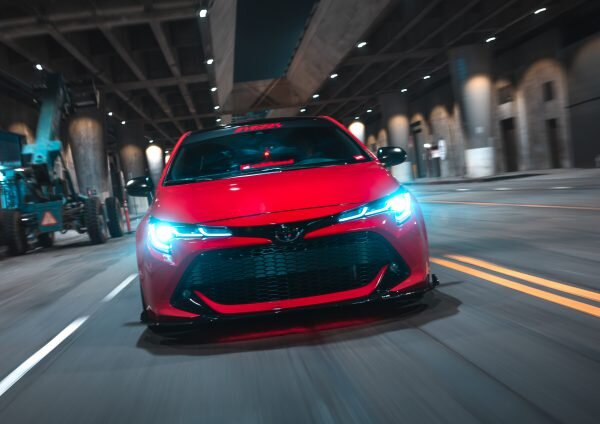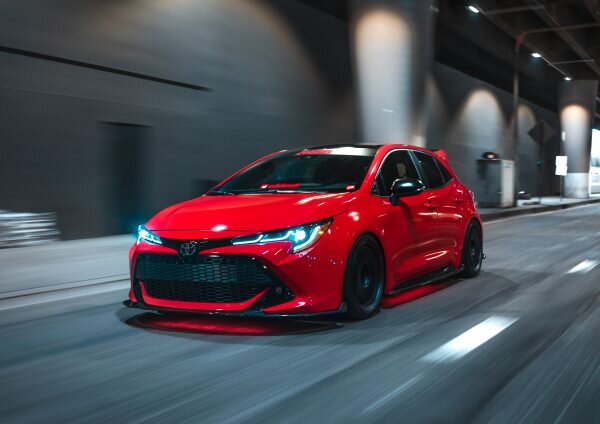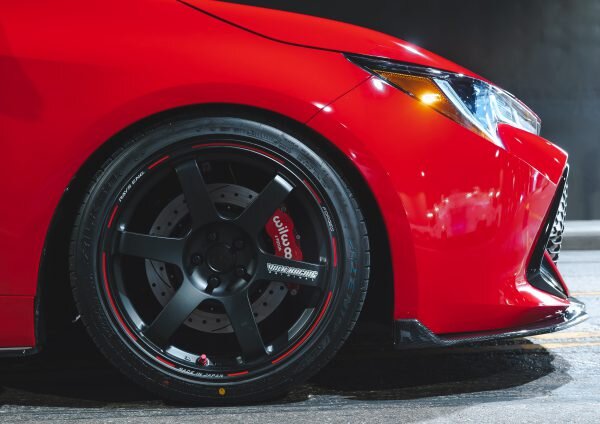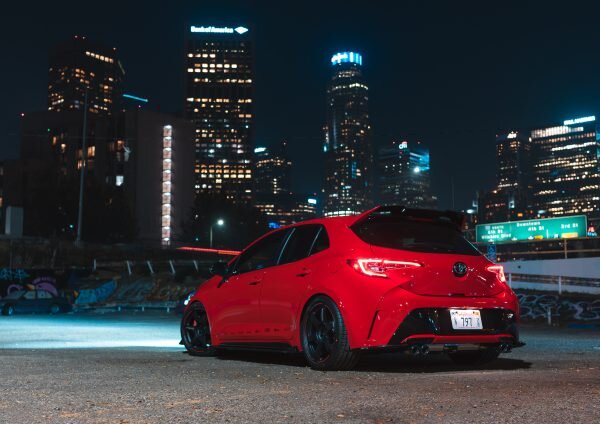Greatest Gazoo signed for NZ: GR GT is a go!
/Glam GT coupe with more kapow than Toyota’s previous ultimate offer, the Lexus LFA, is set to take on NZ roads - and tracks, too.
Read MoreGlam GT coupe with more kapow than Toyota’s previous ultimate offer, the Lexus LFA, is set to take on NZ roads - and tracks, too.
Read MoreAs NZ prepares to release the upgraded production editions of this pocket rocket, home base has shown off an extreme example which installs its bang in the back.
Read MoreMid-life revision for Toyota’s famous pocket rocket and revitalisation of its big brother avails next month, along with a special edition GR 86.
Read MoreThe Track Edition sounds spesh, but it’s the ‘A90 Final Edition’ that’ll stand as the true collectible.
Read MoreThe change everyone knew was coming to Toyota’s baby rocket has given engineers excuse to alter so much more.
Read MoreToyoda talks up battery racer with old-school shifter
Read MoreNo sooner has the Supra become available with manual than a Toyota high-up has revealed the hotshot Yaris and Corolla are going to offer with an auto.
Read MoreSmart styling changes and a firmer suspension tune touted.
Read MoreLatest 2.4-litre car has presented in track-ready form - but Kiwis keen to try it will have to cross the Tasman.
Read MoreThe GR 86 is en route, but the Morizo GR Corolla won’t be.
Read MoreNo price or volume prediction shared for edition, which will sit alongside the existing automatic.
Read MoreSales forecast won’t support TNZ gearing up for this box – but distributor desire might still be strong.
Read MoreHot details of the latest addition to Toyota’s fabulous Gazoo Racing family have been leaked.
Read MoreToyota’s racing development outfit gives the Kiwi favourite a new look – but doesn’t touch the drivetrain.
Read MoreThe new generation Toyota Land Cruiser will have the option of a model with a more sporting flavour.
Read More
AT last it’s out – the second generation of the Toyota 86 that is, still firmly focused on the same goal as the original: Delivering the dreams and the joy of driving inherent in sports cars.
This promise from an unveiling event in Japan today involving Toyota, via its Gazoo Racing franchise into whose hands the car now falls (so, yes, it’s now a GR 86), and co-developer Subaru.
Though shown in what Toyota Gazoo Racing calls a ‘prototype’ format, the new car is also confirmed as an accurate representation of the car as it goes on sale in Japan soon. No news yet from Toyota New Zealand about when it’ll hit here.
Toyota’s version follows in the tyre tracks of the second-generation BRZ (below), which was unveiled last November in the United States. Subaru NZ has straight out nixed conjecture of another BRZ-86 showdown, as occurred in the first year of the previous cars’ release, back in 2012.

Today’s event suggests Toyota’s car has slightly stronger outputs than the Subaru doppelganger, with press material quoting maximum power of 173kW presented at 7000rpm and top torque of 250Nm, coming on at 7400rpm. That’s 3kW and 1Nm more than Subaru quotes.
Either way, it’s still a healthy increase over the maximum outputs from the 2.0-litre car – Subaru quotes 11 percent more power and 15 percent more torque – and it shows in the 0-100kmh time of 6.3 seconds, claimed of course for the manual. The previous model delivered in 7.4s.
The engine has direct injection but forget about a turbocharger; that feature is purely for the North America-only Subaru Ascent SUV from which this engine is more or less plucked.
Toyota says producing optimal grunt at high revs is all part of the fun, but adds the engine’s responsiveness has also been enhanced, providing smooth, stress-free sensations from “low to high rpms.”
The unit continues to run through six-speed transmissions, the auto now having a Sport function, and sending out the oomph through the rear wheels, with the vehicle stability control system offering five settings now to alter the degree of skid-tastic fun.
Macpherson strut front suspension and double-wishbone rear suspension also carries over and even though the chassis is thought to be an improved version of the current cars, the two generations are only identical in 1775mm width.
With a length of 4265mm, height of 1310mm and wheelbase of 2572mm, the GR 86 is 25mm longer, 13mm lower and 6mm longer in wheelbase than the predecessor.

Toyota has quoted a kerb weight of 1270kg (for the manual) and, like Subaru, reminds the car’s roof is now aluminium to bring down the centre of gravity. Aluminum front wings, updated front seats and mufflers contribute to reduced weight.
Body rigidity has been improved, with the goal of offering pleasurable handling in all speed ranges—from urban driving to the upper limits of performance, the maker says. Torsional rigidity has been enhanced by approximately 50 percent over the previous model for greater steering stability.
However, Toyota says the GR86’s shape and aerodynamics have benefitted from the previous model’s immersion into motorsports, such as Toyota NZ’s GR86 (nee TR86) series.
“The GR 86 features aerodynamic components seen on 86 models that participate in motorsports. These include air outlets, side sill spoilers, and other parts that improve steering responsiveness and stability.”
Recent media speculation about Toyota insisting that the GR86 should have a distinct driving feel appears spot on.
Says the Toyota Gazoo Racing release: “While engaging in friendly rivalry with the BRZ development team, TGR sought to develop a vehicle that would provide happiness to 86 fans, and realise an evolution of the 86’s unique driving sensations.
“As a result, the new GR 86 is specially designed for sports performance, and provides direct and satisfying driving performance of the highest order.”

It also says the model is a result of an agreement, signed by the brands in late 2019, to enter into a new business and capital alliance, “as part of which the two companies committed to jointly engage in making ever-better cars.”
“The new GR 86/BRZ is not only a concrete example of this commitment, but also represents a new challenge for both companies, as they seek to subvert conventional ideas of cooperation in the automotive industry.
“Going forward, Toyota and Subaru intend to further ally their respective strengths, deepen their relationship, and so pursue the possibilities of making ever-better cars.”
Toyota says the car’s interior and exterior designs embrace responsive handling and functional beauty and that the model boasts a stance distinctive of front-engine, rear-wheel-drive vehicles. Its low, horizontal underbody and narrow cabin rear combine to create a broad, low-centre-of-gravity appearance.
The cabin design is all about ensuring the driver can concentrate on driving. There’s a new seven inch display screen whose opening animation sequence is “inspired by the piston movements of the horizontally opposed engine, and fosters a sense of excitement even before the drive begins.”
The automatic GR86 alone appears to pick up Subaru’s Eyesight driver assist technology, which include pre-collision safety technologies that help avoid or reduce collision impacts.
Toyota says a total of more than 200,000 first generation 86s have been sold worldwide.

IT’S one of those things every ‘driver’ will claim is dead-easy to do … until they try.
When it comes down to it, achieving a decent drift ain’t half as easy as it looks.
That is, when a human is at the wheel.
When a car is left to do its own thing, turns out big controlled skid action is an utter cinch.
WTF?
Okay, so the car in question isn’t exactly as it departed the production line.
Creating a Toyota Supra that can quite literally drift itself took quite a bit of after-market finetuning. But, wow, as the video shows: Totally worth it!
The prototype, built by engineers from the Toyota Research Institute (TRI) and Stanford University’s ‘Dynamic Design Lab’, is supposed to help the carmaker “develop sophisticated control algorithms that amplify human driving abilities and keep people safe”.
The TRI points out that “while most crashes occur in mundane situations, in other situations drivers may need to make manoeuvres that take their vehicle close to and, at times, exceed normal limits of handling”.
A car that can catch a slide with little to no human intervention would help when drivers “need to make manoeuvres that are beyond their abilities” in order to avoid a collision. In this case, catching a slide brought about by, for example, a driver taking evasive action, their own over-exuberance or poor road conditions.
When it’s up and running, the system will be another tool in the automotive industry’s ever-expanding armoury of driver-assistance systems. Toyota says its active safety technologies will be shared broadly “so that Toyota and other auto manufacturers can deploy it on the road”.

The fourth generation IS is really a big refresh of the old car, but Lexus NZ is confident the update will appeal more to Kiwis and lead to a sales resurgence.
HOW much challenge awaits a highly-rated performance-themed sedan when it delivers with fresh pizzazz – a host of styling and technology tweaks abetting the outgoing model’s well-regarded underpinnings?
Market trend suggests it will still be considerable, the local boss of Lexus concurs, in discussion about the IS.
The consumer rush to crossovers and sports utilities has lifted Lexus but not without loss; that shift is fuelled by sedan abdication. It’s why the GS has been pulled, the ES and LS are down to a sales crawl.
And IS? The past two years’ NZTA registrations relate that the BMW 3-Series fighter has also taken a pummelling; 40 national registrations last year after 63 in 2019.
Not a good graph, you’d think.
And, yet, while IS is down, it isn’t out. There’s confidence it can climb back – potentially into a three-figure sales result this year, Lexus NZ general manager Andrew Davis vouches.

New styling is just part of the IS’s makeover. It also picks up additional technology. The drivetrains and chassis are carried over, though.
Hence why it has unleashed seven derivatives of its smallest rear-drive product, including a new hybrid variant, in a performance theme.
What’s being described as the fourth-generation model is more accurately a big makeover. A number of fresh technologies, improved dynamics and a complete overhaul of its dramatic styling place atop an existing platform, with carryover hybrid and pure petrol powertrains, albeit with a few unique mapping tweaks to increase responsiveness.
Davis sees it as a fresh start car and is confident the 2021 count will be at least double last year’s – perhaps even hitting three figures. However, he concedes the decision to keep the car in circulation was no given.
Could it have been dropped? Simply, yes. Global and local trends could hardly be ignored.
“Consideration for us came into quite a few factors,” Davis says on explaining why it ultimately received a green light, rather than a red.
One was not having a GS. Thought was IS could successfully span into the bigger car’s zone. Also, Lexus took another look at how certain European models were bucking the trend. Specifically? Mercedes C-Class.
“We thought ‘some competitors, particularly Mercedes, are still going quite well with sedans’. We realised that the car the size of IS therefore still has a place. We had also had reasonable success, albeit low volume, with ES. So we thought we still should keep it in the market.”
Still, some will say Lexus NZ is being extraordinarily bold in launching with seven IS derivatives; going by the registrations counts for the past two years, there surely has to be a strong likelihood some of these might represent in availability only and never in true ownership?

Andrew Davis, who now heads Lexus NZ in addition to being head of marketing for Toyota NZ, says the aim this year is to achieve 1000 sales - or more - for the premium marque.
Davis says it’s an interesting question. “We’ve added in an F-Sport hybrid and hybrid is becoming a bigger proportion of our sales … and the technology has gotten better and better. I think people still want the hybrid benefit, but they also want the look, so we’ve added that to our range.” The initial order of six base cars, 13 F-Sport and 16 Limited hybrid models suggests the demand is there and also supports in-house thought that hybrid F-Sport and Limited will be the lead sellers. Ultimately, the market will decide what’s hot and what’s not, yet he’s confident nothing will be left on the shelf.
AS for volumes? Davis asserts there’s every likelihood the bottom of the curve has been reached; from now on, the graph line is ascending. He thinks this year’s IS tally will be at least double the 2020 result, if not exceed 100 units. Which, if achieved, means the car will contribute to 10 percent of the brand’s overall expected volume for this year.
“We definitely expect growth. You do with every new model coming in. I think the styling is more appealing to New Zealanders … the spindle grille is a little more subtle.”
Last year Lexus NZ achieved 818 registrations, with its SUV stock accounting for more than 70 percent of that volume. Davis expects that dominance to ramp up to almost a 75 percent split in 2021, where the target is 1000 units. Or more.
“We are expecting good growth. When Covid was hitting hard – we’re talking July-August – we reduced our (2020) forecast to 650 units. So we are looking at quite a turn.” Last month produced a good start; 131 cars sold. “If you’re looking at 1000, 131 is a good start.” All the same, Lexus is no more immune to any other brand when it comes to sourcing stock. The market is running strong, but fulfilling that demand could well be challenging.

Could you see this car being the basis of another IS-F? The thought intrigues Davis, and there has been scuttlebutt, but nothing concrete.
Now that Toyota has Gazoo Racing, is there latitude for Lexus to revive the full-blown IS-F performance car? Indeed, is there latitude for Lexus – the make that brought the world the astounding V10 LF-A, which Toyota boss Akio Toyoda raced in several Nurburgring 24-Hours, including when the rocketship coupe was still under development - to have anything like Gazoo?
That one raises a reflective laugh from Davis. “There’s nothing on the horizon that I’m aware of. There is speculation on IS-F and I think this speculation just shows there is still market interest in those sorts of cars.”
Lexus has had RC-F and GS-F, so there’s logic to think there might still be space for another IS-F. That the old model has established a cult following also weighs into it.
Still, as much as indications are that if another generation of the V8 monster sedan entered the fray, it might still have a good reception. At same token, though, the realities of modern motoring also cannot be ignored. Emissions, economy … even halo cars don’t get to escape those realities, all the moreso now Government has clarified its clean car intentions.”
The Lexus ‘performance into passion’ credo resonates strongly with him. “You’ve got to have cars that inspire emotions … we need cars that perform really strongly.”
Yes, Lexus held the performance mantle pre-Gazoo, but there’s no sense that the premium brand has been robbed by Toyota’s new motorsport-inspired energy.
“Yes, Gazoo is where the Toyota product is going, but Lexus will still lead, I believe, with performance. It’s just that whether that performance takes a different shape and perhaps with a different powertrain.
“I think what we see is that the motorsport-related performance cars will be Toyota rather than necessarily Lexus, and there is logic in that when you consider where the GR brand is going.
At same token, there’s clear recognition that “consumers connect luxury and performance together. Which is why I say Lexus still needs some element of performance to continue to a leading luxury brand. That’s a challenge we will face.
“When you look future powertrains, Lexus will likely lead with some of that activity. So then it’s what sort of performance does that take.”

UX is already well-received by Lexus buyers and hybrid drivetrains are favoured, so potentially the next-step UX300e full electric should find easy acceptance with customers.
Speaking of … Lexus is very strongly established as a hybrid marque now and soon it will have a full electric car, with the UX300e, arriving later this year (final confirmation pending). What kind of preparation is being considered for that model’s release and marketing?
There’s a challenge in establishing a support infrastructure; Lexus has of course studied how some competitors already operating in the EV-sphere have achieved this. Toyota’s experience with Prius Prime hsd also been invaluable.
“What is going to interest me is the adopters of hybrid - once they have an electric option, will they move, and how quickly will they move. I think they will have good trust in the technologies, because they have already adopted hybrid.”
Price remains an unknown, but it’s the right kind of car for a battery charge, not least given it packages in a bodystyle brand fans are familiar and comfortable with.
“If the model already suits them and it’s just a matter of a different powertrain, then I think they’ll go (EV). It’ll just be in what volumes.
“UX has been a big seller for us and customer feedback is great … it’s the right size for Kiwis, so I cannot see why people wouldn’t go to it.”

SPECULATION about Toyota Japan prepping a Gazoo Racing version of the Corolla sounds sweet to a local brand boss.
When asked for his thoughts about the potential of any such programme, Toyota New Zealand chief operating officer Neeraj Lala was unequivocal: Bring it on.
Talk about the potential of a GR Corolla that would be a direct heir to the celebrated 4AGE 1.6-twin cam AE86 and GT Corollas of the 1980s has re-emerged on strength of a tweet sent out by Toyota America to media.
A message relating that the NZ-confirmed baby GR Yaris hot hatch is not a starter Stateside, the American operation raised flags – and hopes – by adding “it’s time the U.S. got a hot hatch to call its own.”
Commentators saw that as a green light for Corolla, purely on strength that the brand’s top seller is the only other conventional hatchback in the Toyota line-up.
Sounds thin? Well, then consider what might be construed from this sole comment from Lala: “We are working hard on confirming this model, and would love to have it here in NZ.”

Interesting choice of words, right? Does ‘confirming’ mean there’s definitely something going on? Or is this just mischief?
Let’s not forget Toyota America’s interest in the concept of a hot Corolla has already been delivered in exactly that form. The highly-modified one-off special pictured here was a one-off created for the 2018 SEMA show in Las Vegas.
Certainly, Lala and other TNZ high-ups are huge fanboys for Akio Toyoda’s aggressive expansion plan for its GR (Gazoo Racing) high-performance road cars.
NZ was amongst the first export customers for the GR Supra that has revived the brand’s most famous sports car and is also in the queue for the upcoming GR Yaris, a quasi-homologation homage to its World Rally Championship car
If and when a GR Corolla does arrive, then don’t be surprised if it borrowed heavily from the GR Yaris, including using the blitzer baby’s 200kW/370Nm turbocharged 1.5-litre three-cylinder engine and all-wheel drive system.
In addition to Supra and Yaris, the GR clan will also include the next-generation 86 sports coupe – with the GR 86 nameplate – by the end of 2021 and also the GR Super Sport, a road-going version of the race car Toyota is creating to run in the Le Mans hypercar category expected to start in the 2021/22 season, though the category is looking precarious after Aston Martin froze its programme.




MotoringNZ reviews new cars and keeps readers up-to-date with the latest developments on the auto industry. All the major brands are represented. The site is owned and edited by New Zealand motoring journalist Richard Bosselman.